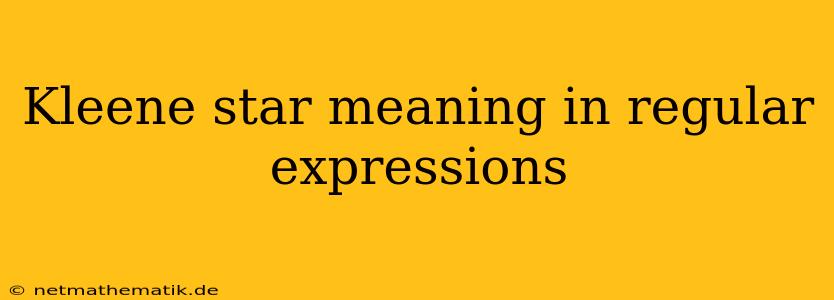The Kleene star, denoted by an asterisk (*), is a fundamental concept in regular expressions. It represents a powerful operation that allows us to match patterns occurring zero or more times. Understanding the Kleene star's meaning is essential for effectively utilizing regular expressions in various tasks such as text processing, data validation, and search engine optimization. This article will delve into the intricacies of the Kleene star, exploring its definition, applications, and how it plays a vital role in the world of regular expressions.
Understanding the Kleene Star
At its core, the Kleene star in regular expressions signifies repetition. It allows you to match a preceding pattern zero or more times. For instance, the regular expression "a*" would match any string consisting of zero or more occurrences of the character "a". This includes strings like "", "a", "aa", "aaa", and so on.
To illustrate its significance, consider the simple example of matching a string containing a sequence of digits. The regular expression "\d*" would match any string consisting of zero or more digits. This means it would successfully match strings like "123", "4567", "", "9", and even "00000".
Applications of the Kleene Star in Regular Expressions
The Kleene star finds extensive applications in various domains, including:
1. Text Processing and Data Validation
- Extracting Phone Numbers: The regular expression
\d{3}-\d{3}-\d{4}would match a phone number formatted as XXX-XXX-XXXX. However, using the Kleene star, we can create a more flexible pattern like\d*-\d*-\d*to capture phone numbers with varying lengths or even missing hyphens. - Email Address Validation: The pattern
\w+@\w+\.\w+validates basic email addresses. However, utilizing the Kleene star, we can create a more robust pattern like\w+@\w+\.\w*to match domains with varying extensions (e.g., .com, .org, .net, etc.). - Website URL Validation: The pattern
https?://\w+\.\w+would match simple website URLs. However, using the Kleene star, we can create a more comprehensive pattern likehttps?://\w+\.\w*to account for URLs with varying paths, query parameters, and subdomains.
2. Search Engine Optimization (SEO)
- Matching Keywords: The Kleene star allows us to create more flexible search queries. For example, the search term "cat*" will match all documents containing "cat", "cats", "catch", "catalog", and so on. This expands the search scope and increases the chance of finding relevant information.
- Website Crawling: Web crawlers use regular expressions to extract information from web pages. The Kleene star is crucial in defining flexible patterns for identifying specific elements like links, images, or text blocks.
3. Programming Languages and Scripting
- Parsing Code: In compilers and interpreters, regular expressions with Kleene stars are used to parse source code, identify keywords, and analyze syntax. For example, the pattern
[a-zA-Z_]\w*can be used to match variable names in various programming languages. - Pattern Matching: Regular expressions with Kleene stars are widely employed in scripting languages like Python and JavaScript for various tasks such as data manipulation, string processing, and file analysis.
Conclusion
The Kleene star is a powerful tool in the arsenal of regular expressions. It provides a flexible and efficient way to match patterns that occur zero or more times, offering significant advantages in tasks ranging from text processing and data validation to web crawling and programming. By understanding the Kleene star's meaning and its various applications, we can leverage its potential to create sophisticated regular expressions that can tackle complex patterns with ease.
